Davide Dardari
Scalable RIS-Aided Beamforming Strategies for Near-Field MU-MISO via Multi-Antenna Feeder
Aug 12, 2025Abstract:This paper investigates a modular beamforming framework for reconfigurable intelligent surface (RIS)-aided multi-user (MU) communications in the near-field regime, built upon a novel antenna architecture integrating an active multi-antenna feeder (AMAF) array with a transmissive RIS (T-RIS), referred to as AT-RIS. This decoupling enables coordinated yet independently configurable designs in the AMAF and T-RIS domains, supporting flexible strategies with diverse complexity-performance trade-offs. Several implementations are analyzed, including diagonal and non-diagonal T-RIS architectures, paired with precoding schemes based on focusing, minimum mean square error, and eigenmode decomposition. Simulation results demonstrate that while non-diagonal schemes maximize sum rate in scenarios with a limited number of User Equipments (UEs) and high angular separability, they exhibit fairness and scalability limitations as UE density increases. Conversely, diagonal T-RIS configurations, particularly the proposed focusing-based scheme with uniform feeder-side power allocation, offer robust, fair, and scalable performance with minimal channel state information. The findings emphasize the critical impact of UEs' angular separability and reveal inherent trade-offs among spectral efficiency, complexity, and fairness, positioning diagonal AT-RIS architectures as practical solutions for scalable near-field MU multiple-input single-output systems.
Frequency-selective Dynamic Scattering Arrays for Over-the-air EM Processing
Feb 11, 2025Abstract:In this paper, we investigate frequency-selective dynamic scattering array (DSA), a versatile antenna structure capable of performing joint wave-based computing and radiation by transitioning signal processing tasks from the digital domain to the electromagnetic (EM) domain. The numerical results demonstrate the potential of DSAs to produce space-frequency superdirective responses with minimal usage of radiofrequency (RF) chains, making it particularly attractive for future holographic multiple-input multiple-output (MIMO) systems.
An Overview on Over-the-air Electromagnetic Signal Processing
Dec 20, 2024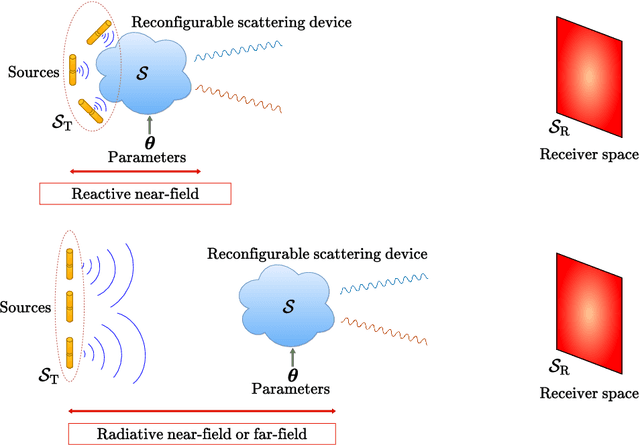
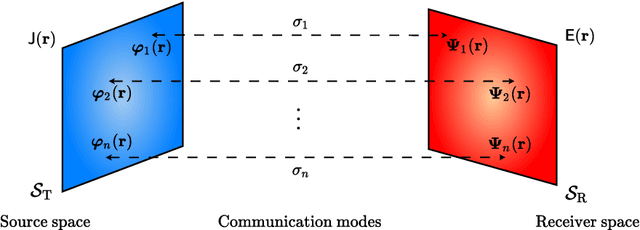
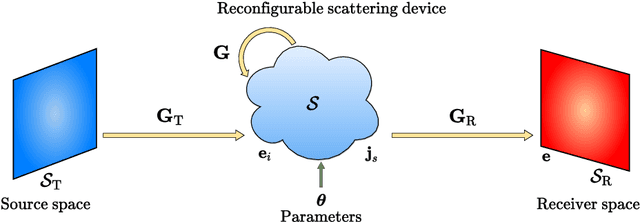
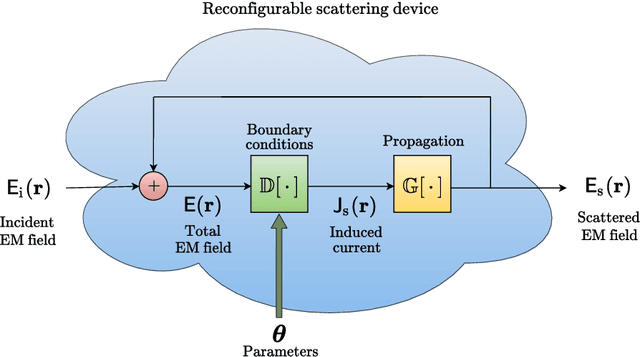
Abstract:This article provides a tutorial on over-the-air electromagnetic signal processing (ESP) for next-generation wireless networks, addressing the limitations of digital processing to enhance the efficiency and sustainability of future 6th Generation (6G) systems. It explores the integration of electromagnetism and signal processing (SP) highlighting how their convergence can drive innovations for 6G technologies. Key topics include electromagnetic (EM) wave-based processing, the application of metamaterials and advanced antennas to optimize EM field manipulation with a reduced number of radiofrequency chains, and their applications in holographic multiple-input multiple-output systems. By showcasing enabling technologies and use cases, the article demonstrates how wave-based processing can minimize energy consumption, complexity, and latency, offering an effective framework for more sustainable and efficient wireless systems. This article aims to assist researchers and professionals in integrating advanced EM technologies with conventional SP methods.
An Overview on Over-the-airElectromagnetic Signal Processing
Dec 19, 2024



Abstract:This article provides a tutorial on over-the-air electromagnetic signal processing (ESP) for next-generation wireless networks, addressing the limitations of digital processing to enhance the efficiency and sustainability of future 6th Generation (6G) systems. It explores the integration of electromagnetism and signal processing (SP) highlighting how their convergence can drive innovations for 6G technologies. Key topics include electromagnetic (EM) wave-based processing, the application of metamaterials and advanced antennas to optimize EM field manipulation with a reduced number of radiofrequency chains, and their applications in holographic multiple-input multiple-output systems. By showcasing enabling technologies and use cases, the article demonstrates how wave-based processing can minimize energy consumption, complexity, and latency, offering an effective framework for more sustainable and efficient wireless systems. This article aims to assist researchers and professionals in integrating advanced EM technologies with conventional SP methods.
Beam Focusing for Near-Field Multi-User Localization
Jul 24, 2024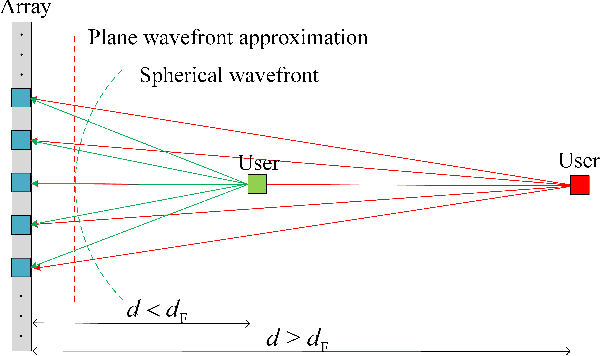
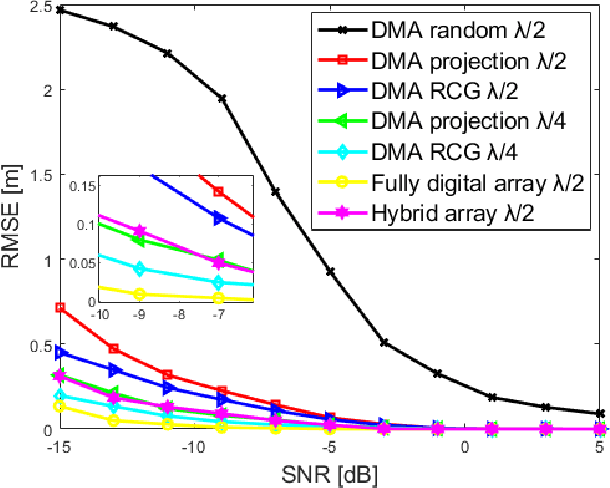
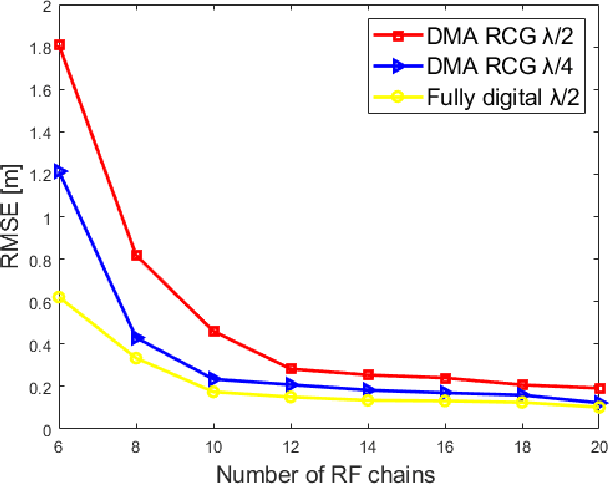
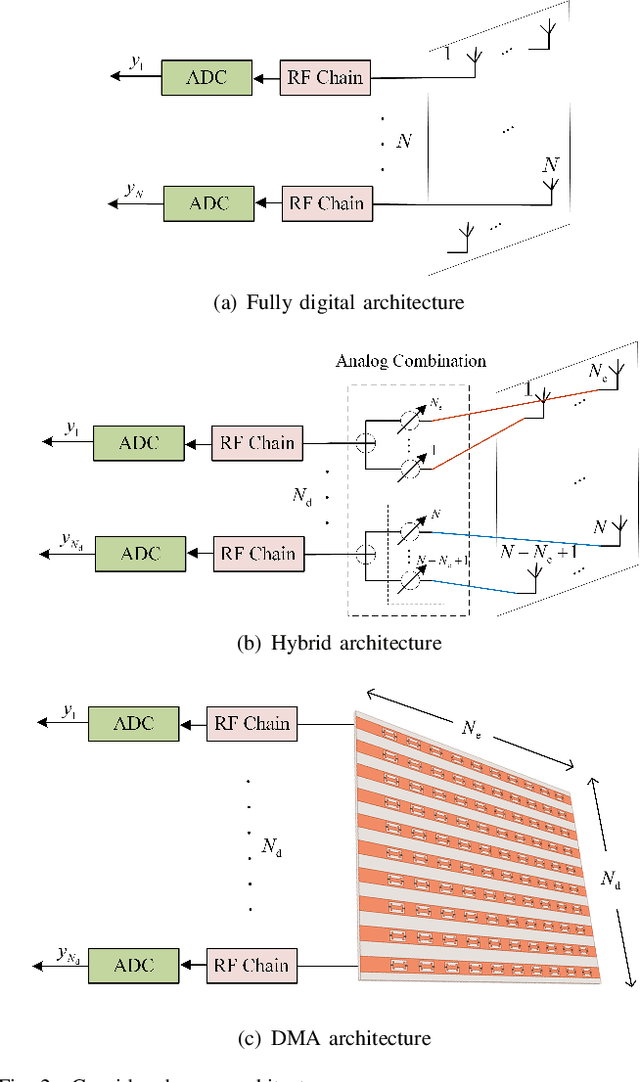
Abstract:Extremely large-scale antenna arrays are poised to play a pivotal role in sixth-generation (6G) networks. Utilizing such arrays often results in a near-field spherical wave transmission environment, enabling the generation of focused beams, which introduces new degrees of freedom for wireless localization. In this paper, we consider a beam-focusing design for localizing multiple sources in the radiating near-field. Our formulation accommodates various expected types of implementations of large antenna arrays, including hybrid analog/digital architectures and dynamic metasurface antennas (DMAs). We consider a direct localization estimation method exploiting curvature-of-arrival of impinging spherical wavefront to obtain user positions. In this regard, we adopt a two-stage approach configuring the array to optimize near-field positioning. In the first step, we focus only on adjusting the array coefficients to minimize the estimation error. We obtain a closed-form approximate solution based on projection and the better one based on the Riemann gradient algorithm. We then extend this approach to simultaneously localize and focus the beams via a sub-optimal iterative approach that does not rely on such knowledge. The simulation results show that near-field localization accuracy based on a hybrid array or DMA can achieve performance close to that of fully digital arrays at a lower cost, and DMAs can attain better performance than hybrid solutions with the same aperture.
Bistatic Sensing at THz Frequencies via a Two-Stage Ultra-Wideband MIMO-OFDM System
May 28, 2024Abstract:Only the chairs can edit The availability of abundant bandwidth at terahertz (THz) frequencies holds promise for significantly enhancing the sensing performance of integrated sensing and communication (ISAC) systems in the next-generation wireless systems, enabling high accuracy and resolution for precise target localization. In orthogonal frequency-division multiplexing (OFDM) systems, wide bandwidth can be achieved by increasing the subcarrier spacing rather than the number of subcarriers, thereby keeping the complexity of the sensing system low. However, this approach may lead to an ambiguity problem in target range estimation. To address this issue, this work proposes a two-stage maximum likelihood method for estimating target position in an ultra-wideband bistatic multiple-antenna OFDM-based ISAC system operating at THz frequencies. Numerical results show that the proposed estimation approach effectively resolves the ambiguity problem while achieving high resolution and accuracy target position estimation at a very low signal-to-noise ratio regime.
A Deep-NN Beamforming Approach for Dual Function Radar-Communication THz UAV
May 27, 2024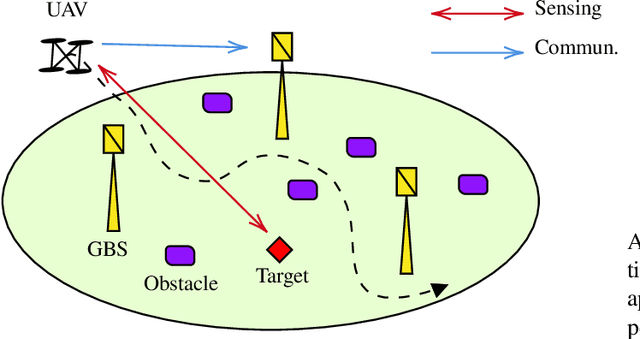
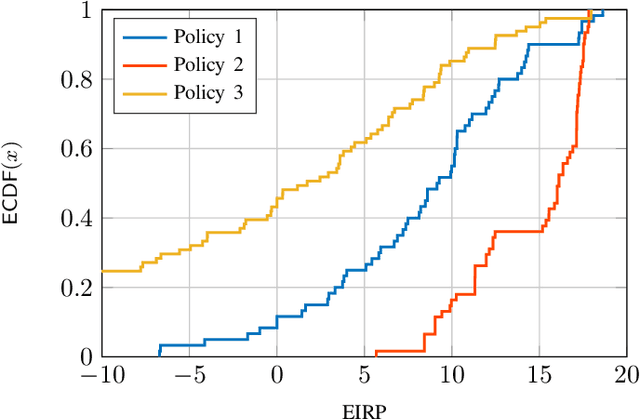
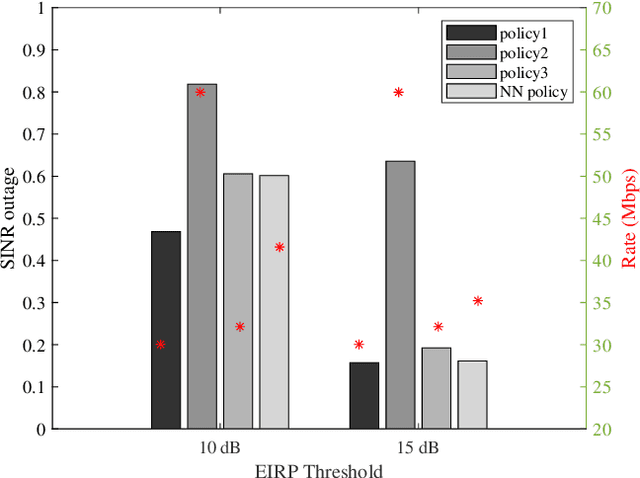

Abstract:In this paper, we consider a scenario with one UAV equipped with a ULA, which sends combined information and sensing signals to communicate with multiple GBS and, at the same time, senses potential targets placed within an interested area on the ground. We aim to jointly design the transmit beamforming with the GBS association to optimize communication performance while ensuring high sensing accuracy. We propose a predictive beamforming framework based on a dual DNN solution to solve the formulated nonconvex optimization problem. A first DNN is trained to produce the required beamforming matrix for any point of the UAV flying area in a reduced time compared to state-of-the-art beamforming optimizers. A second DNN is trained to learn the optimal mapping from the input features, power, and EIRP constraints to the GBS association decision. Finally, we provide an extensive simulation analysis to corroborate the proposed approach and show the benefits of EIRP, SINR performance and computational speed.
Dynamic Scattering Arrays for Simultaneous Electromagnetic Processing and Radiation in Holographic MIMO Systems
May 25, 2024Abstract:To meet the stringent requirements of next-generation wireless networks, multiple-input multiple-output (MIMO) technology is expected to become massive and pervasive. Unfortunately, this could pose scalability issues in terms of complexity, power consumption, cost, and processing latency. Therefore, novel technologies and design approaches, such as the recently introduced holographic MIMO paradigm, must be investigated to make future networks sustainable. In this context, we propose the concept of a dynamic scattering array (DSA) as a versatile 3D structure capable of performing joint wave-based computing and radiation by moving the processing from the digital domain to the electromagnetic (EM) domain. We provide a general analytical framework for modeling DSAs, introduce specific design algorithms, and apply them to various use cases. The examples presented in the numerical results demonstrate the potential of DSAs to further reduce complexity and the number of radiofrequency (RF) chains in holographic MIMO systems while achieving enhanced EM wave processing and radiation flexibility for tasks such as beamforming and single- and multi-user MIMO.
Performance Bounds for Velocity Estimation with Large Antenna Arrays
May 08, 2024Abstract:Joint communication and sensing (JCS) is envisioned as an enabler of future 6G networks. One of the key features of these networks will be the use of extremely large aperture arrays (ELAAs) and high operating frequencies, which will result in significant near-field propagation effects. This unique property can be harnessed to improve sensing capabilities. In this paper, we focus on velocity sensing, as using ELAAs allows the estimation of not just the radial component but also the transverse component. We derive analytical performance bounds for both velocity components, demonstrating how they are affected by the different system parameters and geometries. These insights offer a foundational understanding of how near-field effects play in velocity sensing differently from the far field and from position estimate.
An Overview of Intelligent Meta-surfaces for 6G and Beyond: Opportunities, Trends, and Challenges
May 06, 2024Abstract:With the impending arrival of the sixth generation (6G) of wireless communication technology, the telecommunications landscape is poised for another revolutionary transformation. At the forefront of this evolution are intelligent meta-surfaces (IS), emerging as a disruptive physical layer technology with the potential to redefine the capabilities and performance metrics of future wireless networks. As 6G evolves from concept to reality, industry stakeholders, standards organizations, and regulatory bodies are collaborating to define the specifications, protocols, and interoperability standards governing IS deployment. Against this background, this article delves into the ongoing standardization efforts, emerging trends, potential opportunities, and prevailing challenges surrounding the integration of IS into the framework of 6G and beyond networks. Specifically, it provides a tutorial-style overview of recent advancements in IS and explores their potential applications within future networks beyond 6G. Additionally, the article identifies key challenges in the design and implementation of various types of intelligent surfaces, along with considerations for their practical standardization. Finally, it highlights potential future prospects in this evolving field.
 Add to Chrome
Add to Chrome Add to Firefox
Add to Firefox Add to Edge
Add to Edge